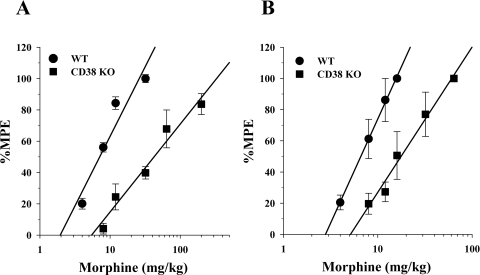Fig. 4.
Acute effects of morphine in antinociception assays in CD38 KO mice. A, acute effects of morphine in the warm-water tail immersion test. Mice were injected with various doses of morphine subcutaneously, and their tail immersion latencies were determined for construction of dose–response curves 30 min later. Data are expressed as mean %MPE ± S.E.M. Each data point represents 6 to 10 mice. The morphine ED50 values were as follows: wild type, 8.4 mg/kg (95% CL 6.7–10.6); CD38 KO, 34.3 mg/kg (95% CL 24.5–4.9). Morphine was found to be 4-fold less potent in the CD39 KO mice than in wild-type mice in this test. B, acute effects of morphine in the hotplate test. Mice were injected with various doses of morphine subcutaneously, and their hotplate test latencies were determined for construction of dose–response curves 30 min later. Data are expressed as mean %MPE ± S.E.M. Each data point represents 6 to 10 mice. The morphine ED50 values were as follows: wild type, 6.6 mg/kg (95% CL 5.6–7.8); CD38 KO, 39.8 mg/kg (95% CL 18.5–85.9). Morphine was found to be 6-fold less potent in the CD38 KO mice than in wild-type mice in this test.

